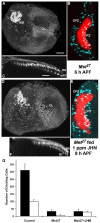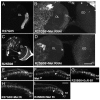A role for juvenile hormone in the prepupal development of Drosophila melanogaster
- PMID: 20181742
- PMCID: PMC2835327
- DOI: 10.1242/dev.037218
A role for juvenile hormone in the prepupal development of Drosophila melanogaster
Abstract
To elucidate the role of juvenile hormone (JH) in metamorphosis of Drosophila melanogaster, the corpora allata cells, which produce JH, were killed using the cell death gene grim. These allatectomized (CAX) larvae were smaller at pupariation and died at head eversion. They showed premature ecdysone receptor B1 (EcR-B1) in the photoreceptors and in the optic lobe, downregulation of proliferation in the optic lobe, and separation of R7 from R8 in the medulla during the prepupal period. All of these effects of allatectomy were reversed by feeding third instar larvae on a diet containing the JH mimic (JHM) pyriproxifen or by application of JH III or JHM at the onset of wandering. Eye and optic lobe development in the Methoprene-tolerant (Met)-null mutant mimicked that of CAX prepupae, but the mutant formed viable adults, which had marked abnormalities in the organization of their optic lobe neuropils. Feeding Met(27) larvae on the JHM diet did not rescue the premature EcR-B1 expression or the downregulation of proliferation but did partially rescue the premature separation of R7, suggesting that other pathways besides Met might be involved in mediating the response to JH. Selective expression of Met RNAi in the photoreceptors caused their premature expression of EcR-B1 and the separation of R7 and R8, but driving Met RNAi in lamina neurons led only to the precocious appearance of EcR-B1 in the lamina. Thus, the lack of JH and its receptor Met causes a heterochronic shift in the development of the visual system that is likely to result from some cells 'misinterpreting' the ecdysteroid peaks that drive metamorphosis.
Figures









Similar articles
-
Juvenile hormone counteracts the bHLH-PAS transcription factors MET and GCE to prevent caspase-dependent programmed cell death in Drosophila.Development. 2009 Jun;136(12):2015-25. doi: 10.1242/dev.033712. Development. 2009. PMID: 19465595
-
Activities of natural methyl farnesoids on pupariation and metamorphosis of Drosophila melanogaster.J Insect Physiol. 2010 Oct;56(10):1456-64. doi: 10.1016/j.jinsphys.2010.06.001. Epub 2010 Jun 15. J Insect Physiol. 2010. PMID: 20541556
-
Ecdysone differentially regulates metamorphic timing relative to 20-hydroxyecdysone by antagonizing juvenile hormone in Drosophila melanogaster.Dev Biol. 2014 Jul 1;391(1):32-42. doi: 10.1016/j.ydbio.2014.04.004. Epub 2014 Apr 13. Dev Biol. 2014. PMID: 24727669
-
Hormone receptors and the regulation of insect metamorphosis.Receptor. 1993 Fall;3(3):203-9. Receptor. 1993. PMID: 8167571 Review.
-
The development and function of neuronal subtypes processing color and skylight polarization in the optic lobes of Drosophila melanogaster.Arthropod Struct Dev. 2021 Mar;61:101012. doi: 10.1016/j.asd.2020.101012. Epub 2021 Feb 19. Arthropod Struct Dev. 2021. PMID: 33618155 Review.
Cited by
-
Comprehensive and Durable Modulation of Growth, Development, Lifespan and Fecundity in Anopheles stephensi Following Larval Treatment With the Stress Signaling Molecule and Novel Antimalarial Abscisic Acid.Front Microbiol. 2020 Jan 17;10:3024. doi: 10.3389/fmicb.2019.03024. eCollection 2019. Front Microbiol. 2020. PMID: 32010091 Free PMC article.
-
MET is required for the maximal action of 20-hydroxyecdysone during Bombyx metamorphosis.PLoS One. 2012;7(12):e53256. doi: 10.1371/journal.pone.0053256. Epub 2012 Dec 27. PLoS One. 2012. PMID: 23300902 Free PMC article.
-
takeout-dependent longevity is associated with altered Juvenile Hormone signaling.Mech Ageing Dev. 2012 Nov-Dec;133(11-12):637-46. doi: 10.1016/j.mad.2012.08.004. Epub 2012 Aug 30. Mech Ageing Dev. 2012. PMID: 22940452 Free PMC article.
-
Molecular Mechanisms of Transcription Activation by Juvenile Hormone: A Critical Role for bHLH-PAS and Nuclear Receptor Proteins.Insects. 2012 Mar 22;3(1):324-38. doi: 10.3390/insects3010324. Insects. 2012. PMID: 26467963 Free PMC article. Review.
-
Transcriptional regulation of insect steroid hormone biosynthesis and its role in controlling timing of molting and metamorphosis.Dev Growth Differ. 2016 Jan;58(1):94-105. doi: 10.1111/dgd.12248. Epub 2015 Dec 15. Dev Growth Differ. 2016. PMID: 26667894 Free PMC article. Review.
References
-
- Bownes M., Rembold H. (1987). The titre of juvenile hormone during the pupal and adult stages of the life cycle of Drosophila melanogaster. Eur. J. Biochem. 164, 709-712 - PubMed
-
- Champlin D. T., Truman J. W. (1998a). Ecdysteroids govern two phases of eye development during metamorphosis of the moth, Manduca sexta. Development 125, 2009-2018 - PubMed
-
- Champlin D. T., Truman J. W. (1998b). Ecdysteroid control of cell proliferation during optic lobe neurogenesis in the moth, Manduca sexta. Development 125, 269-277 - PubMed
Publication types
MeSH terms
Substances
Grants and funding
LinkOut - more resources
Full Text Sources
Molecular Biology Databases
Miscellaneous

